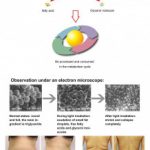Light therapy, also known as phototherapy, is a form of treatment that uses light in various wavelengths to help alleviate a range of physical and mental conditions. In this therapy, a person is exposed to a specific type of light for a certain amount of time each day. It is often used to treat seasonal affective disorder, sleep disorders, acne, skin conditions, and other conditions that may benefit from exposure to light. Light therapy can be administered using different types of light sources, including bright light boxes, handheld devices, light visors, and lamps. This therapy is considered safe and effective for most people, but it is important to discuss it with a healthcare professional before incorporating it into a treatment plan.
Contents
Shedding Light on Light Therapy: What Is It?
If you’re looking for a non-invasive, drug-free way to improve your mood, sleep, and skin health, light therapy may be just what you need. This therapy uses specific wavelengths of light, usually from the blue and red spectrum, to stimulate the body’s natural healing processes. Light therapy can also help regulate your circadian rhythm, making it easier to fall asleep and wake up at the right times.
How Does Light Therapy Work?
Light therapy works by penetrating the skin and stimulating the body’s cells to produce more energy. This process, called photobiomodulation, can have a range of beneficial effects on the body. For example, red light therapy has been shown to reduce inflammation, while blue light therapy can help kill acne-causing bacteria.
What Are the Benefits of Light Therapy?
The benefits of light therapy are many and varied. Here are just a few:
- Improved mood and energy levels
- Reduced symptoms of depression and anxiety
- Better sleep quality and duration
- Reduced inflammation and pain
- Improved skin health and appearance
- Increased wound healing and tissue repair
Brightening Your Day: How to Use Light Therapy
Now that you understand the basics of light therapy, you may be wondering how to incorporate it into your life. Here are some tips for getting started:
Types of Light Therapy
There are several types of light therapy devices available, including light boxes, lamps, and wearable devices. Light boxes are the most common type and are typically used to treat seasonal affective disorder (SAD).
How to Use Light Therapy
To use light therapy, you’ll need to sit or stand in front of the light box for a specified amount of time each day. The amount of time will depend on the intensity of the light and your individual needs.
Safety Precautions
While light therapy is generally safe, there are some precautions you should take. For example, you should never look directly at the light source or exceed the recommended exposure time.
Shedding Light on the Science Behind Light Therapy
Light therapy is a relatively new field of study, but researchers are starting to understand more about how it works and its potential benefits. Here are some of the latest findings:
Light therapy is an effective, non-invasive, drug-free way to improve your mood, sleep, and skin health. It works by using specific wavelengths of light to stimulate the body’s natural healing processes, making it easier to fall asleep and wake up at the right times. Red light therapy can help reduce inflammation and pain, while blue light therapy can improve the overall appearance of acne-prone skin. Using light therapy devices like light boxes, lamps, and wearable devices, individuals can sit or stand in front of the light box for a specified amount of time each day to regulate their circadian rhythm and bring light to their path of healing and wellness.


.jpg)
.jpg)



